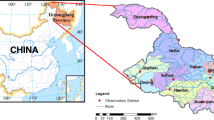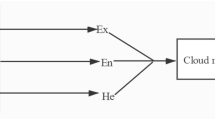We are facing the water shortage crisis. To realise sustainable development, we should improve water-use efficiency (WUE). In this study, a cloud–compound fuzzy matter element–entropy combined model was constructed to evaluate WUE. The Huai river basin (HRB) was selected as the study area. The cloud model was used to select some indices and build the comprehensive evaluation index system (CEIS), which included the overall, agricultural, industrial, domestic and environmental categories. The compound fuzzy matter element model was used to calculate the comprehensive indicators of WUE of the HRB and its regions. The weight of each index in the CEIS was determined using the entropy model. The results showed that WUE of the HRB had an upward trend on the whole because of the enhanced emphasis on water resources by the international and national governments. However, the regional difference was obvious. The WUE of Henan province was higher than that of Jiangsu province. The imbalance of regional WUE is an international problem. By analysing the difference among regions, research can provide a reference for the decision making of the water resources management department.








Similar content being viewed by others
References
Adedeji A A and Ako R T 2011 Towards achieving the United Nations’ millennium development goals: The imperative of reforming water pollution control and waste management laws in Nigeria; Desalination 248(1) 642–649.
Ali M K and Klein K K 2014 Water use efficiency and productivity of the irrigation districts in Southern Alberta; Water Resour. Manag. 28(10) 2751–2766.
Amiri V, Rezaei M and Sohrabi N 2014 Groundwater quality assessment using entropy weighted water quality index (EWQI) in Lenjanat, Iran; Env. Earth Sci. 72(9) 3479–3490.
Azad M A and Ancev T 2014 Measuring environmental efficiency of agricultural water use: A Luenberger environmental indicator; J. Env. Manag. 145(145C) 314–320.
Chen J, Zhang F and Yang C et al. 2017 Factor and trend analysis of total-loss marine casualty using a fuzzy matter element method; Int. J. Disast. Risk Re. 24 383–390.
Chen Y J, Liu D W, Zhu D Y, Zheng R K, Feng B J and Ni Y 2015 Comprehensive safety evaluation of ship ammunition depot based on cloud model; J. Saf. Sci. Technol. 2015-2 138–144.
Christiansen B 2009 Is the atmosphere interesting? A projection pursuit study of the circulation in the Northern Hemisphere winter; J. Clim. 22(22) 1239–1254.
Deng X, Xu Y, Han L, Yu Z, Yang M and Pan G 2015 Assessment of river health based on an improved entropy-based fuzzy matter-element model in the Taihu plain, China; Ecol. Indic. 57 85–95.
Dong L, Wang P and Yan F 2016 Damage forecasting based on multi-factor fuzzy time series and cloud model; J. Intell. Manuf. 2019(2) 1–18.
FAO AQUASTAT 2005–2016 Rome, Food and Agriculture Organization of the United Nations (FAO; http://www.fao.org/nr/water/aquastat/main/index.stm).
Fujii H, Managi S and Kaneko S 2012 A water resource efficiency analysis of the Chinese industrial sector; Env. Econ. 3(3) 82–92.
Guan X J, Liang S X and Meng Y 2016 Evaluation of water resources comprehensive utilization efficiency in Yellow River basin; Water Sci. Tech.-Water Sup. 16(6).
Guo Z C and Fu Z X 2010 Current situation of energy consumption and measures taken for energy saving in the iron and steel industry in China; Energy 35(11) 4356–4360.
Hu S Y, Li D R, Liu Y L and Li D Y 2007 Mining weights of land evaluation factors based on cloud model and correlation analysis; Geo-Spatial Inf. Sci. 10(3) 218–222.
Kallon S B 2008 Pollution and sanitation problems as setbacks to sustainable water resources management in Freetown; J. Env. Health 71(5) 34–37.
Karimi P, Molden D, Bastiaanssen W and Cai X 2012 Water accounting to assess use and productivity of water-evolution of the concept and new frontiers; In: Water accounting: International approaches to policy and decision-making (eds) Chalmers K and Godfrey J, Chapter 4, Edgar Elger, Cheltenham, UK, pp. 76–88.
Keshavarzi A R, Sharifzadeh M, Kamgar Haghighi A A, Amin S, Sh K and Bamdad A 2006 Rural domestic water consumption behavior: A case study in Ramjerd area, Fars province, I.R. Iran; Water Res. 40(6) 1173–1178.
Khan M Y A, Khan B and Chakrapani G J 2016 Assessment of spatial variations in water quality of Garra River at Shahjahanpur, Ganga Basin, India; Arab. J. Geosci. 9(8) 516.
Kujinga K, Vanderpost C, Mmopelwa G and Wolski P 2014 An analysis of factors contributing to household water security problems and threats in different settlement categories of Ngamiland, Botswana; Phys. Chem. Earth 67–69(2) 187–201.
Lei M T 2017 Application of SFLA-PP model to comprehensive evaluation of utilization efficiency of regional water resources; J. Yangtze River Sci. Res. Inst. 34(11) 27–32.
Li D, Liu C and Gan W 2009 A new cognitive model: Cloud model; Int. J. Intell. Syst. 24(3) 357–375.
Lu S, Bao H and Pan H 2016 Urban water security evaluation based on similarity measure model of Vague sets; Int. J. Hydrog. Energy 41(35) 15944–15950.
Maruyama T, Kawachi T and Singh V P 2005 Entropy-based assessment and clustering of potential water resources availability; J. Hydrol. 309(1) 104–113.
Moore A D, Robertson M J and Routley R 2011 Evaluation of the water use efficiency of alternative farm practices at a range of spatial and temporal scales: A conceptual framework and a modelling approach; Agr. Syst. 104(2) 162–174.
Pan G, Xu Y, Yu Z, Song S and Zhang Y 2015 Analysis of river health variation under the background of urbanization based on entropy weight and matter-element model: A case study in Huzhou city in the Yangtze river delta, China; Env. Res. 139 31–35.
Playan E and Mateos L 2006 Modernization and optimization of irrigation systems to increase water productivity; Agri. Water Manag. 79(1) 100–116.
Qin K, Liu F, Liu F and Li D 2011 Image segmentation based on histogram analysis utilizing the cloud model; Comput. Math. Appl. 62(7) 2824–2833.
Orencio P M and Fujii M 2013 A localized disaster-resilience index to assess coastal communities based on an analytic hierarchy process (AHP); Int. J. Disast. Risk Re. 3 62–75.
Sadras V O, Grassini P and Steduto P 2012 Status of water use efficiency of main crops; SOLAW Background Thematic Report TR07. United Nations FAO, Rome, Italy.
Simonovic S P 2017 Bringing future climatic change into water resources management practice today; Water Resour. Manag. 31(10) 2933–2950.
SIWI 2010 World Water Week 2010: Responding to Global Changes: The Water Quality Challenge-Prevention, Wise Use and Abatement; Stockholm International Water Institute.
Surhone L M, Tennoe M T and Henssonow S F 2010 World water week in Stockholm; Saarbrzcken; VDM Verlag Dr. Mueller e.K.
Sun S, Wang Y, Liu J, Cai H, Wu P and Geng Q et al. 2016 Sustainability assessment of regional water resources under the DPSIR framework; J. Hydrol. 532 140–148.
Tal A 2016 Rethinking the sustainability of Israel’s irrigation practices in the Drylands; Water Res. 90 387–394.
UN 2015a The United Nations World Water Development Report 2015: Water for a sustainable world; United Nations.
UN 2015b Transforming our world: The 2030 agenda for sustainable development; United Nations.
UN 2018 The United Nations World Water Development Report 2018: Nature-based solutions for water; United Nations.
Vaidyaab O S 2006 Analytic hierarchy process: An overview of applications; Eur. J. Oper. Res. 169(1) 1–29.
Wang G, Xu C and Li D 2014 Generic normal cloud model; Inf. Sci. 280(280) 1–15.
Wang M, Sun Y, Hou J, Wang X, Bai X and Wu C, et al. 2017 A comparison of food crispness based on the cloud model; J. Texture Stud. 49(1).
Wang Y, Yin X, Jing H, Liu R and Su H 2016 A novel cloud model for risk analysis of water inrush in karst tunnels; Env. Earth Sci. 75(22) 1450.
Wu J, Li P, Qian H and Chen J 2015 On the sensitivity of entropy weight to sample statistics in assessing water quality: Statistical analysis based on large stochastic samples; Env. Earth Sci. 74(3) 2185–2195.
Xu S D, Geng X L and Dong X Q 2018 Improved FMEA approach for risk evaluation based on cloud model; Comput. Eng. Appl. 54(2) 228–233.
Yan L, Ma J, Deng W and Wang Y 2018 International comparison of water resources utilization efficiency in the Silk Road economic belt; IOP Conf. Ser., Earth Environ. Sci. 128 012041.
Yang L Y, Xu X Y and Jia X X 2009 Water use efficiency evaluating index system; J. Beijing Normal Univ., Nat. Sci. 45(5–6) 642–646.
Yu S and Lu H 2018 An integrated model of water resources optimization allocation based on projection pursuit model-Grey Wolf optimization method in a transboundary river basin; J. Hydrol. 559.
Zhang T, Yan L and Yang Y 2018a Trust evaluation method for clustered wireless sensor networks based on cloud model; Wirel. Netw. 24(3) 777–797.
Zhang X, Meng Y, Xia J, Wu B and She D X 2018b A combined model for river health evaluation based upon the physical, chemical, and biological elements; Ecol. Indic. 84.
Acknowledgements
The authors would like to express their gratitude to everyone who provided assistance towards this study. This study was financially supported by the National Natural Science Foundation of China (Grant Nos. 51879241, 51809239 and 51739009).
Author information
Authors and Affiliations
Corresponding author
Additional information
Communicated by Rajib Maity
Rights and permissions
About this article
Cite this article
Guan, X., Qin, H., Meng, Y. et al. Comprehensive evaluation of water-use efficiency in China’s Huai river basin using a cloud–compound fuzzy matter element–entropy combined model. J Earth Syst Sci 128, 179 (2019). https://doi.org/10.1007/s12040-019-1206-6
Received:
Revised:
Accepted:
Published:
DOI: https://doi.org/10.1007/s12040-019-1206-6




